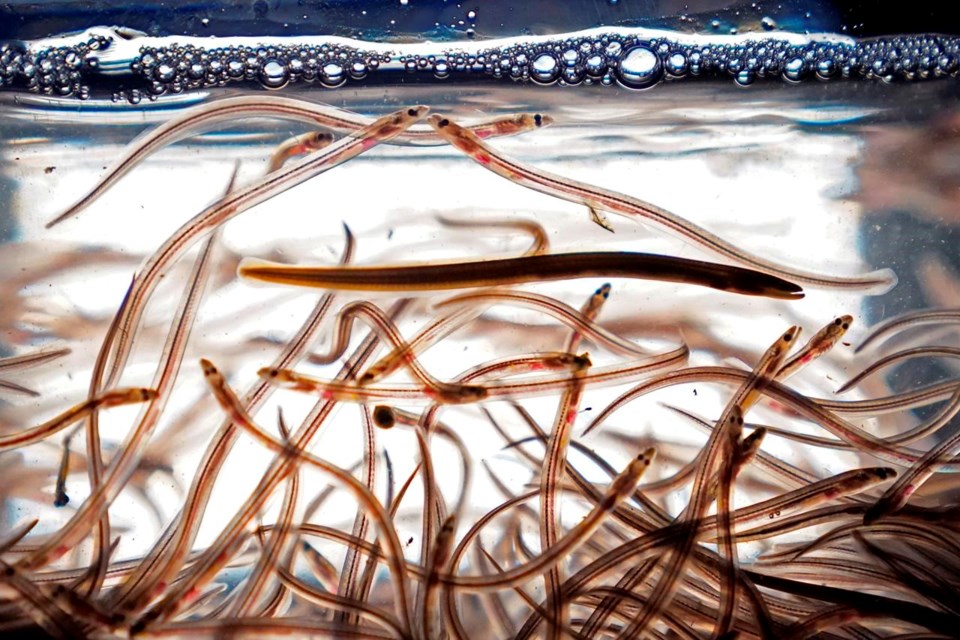HALIFAX — Commercial harvesters of baby eels in the Maritimes say there’s little hope the poaching and violence that forced the closure of the lucrative fishery last season will subside in 2024.
The federal Department of Fisheries and Oceans closed the fishery for the tiny, translucent fish known as elvers on April 15 after reports of violence related to unauthorized fishing. There were accusations of assault and even shots fired along coastal rivers in parts of Nova Scotia and New Brunswick.
The increased illegal activity comes as demand grows for the young eels, which are sold live to aquaculture operations in Asian markets such as China and Japan, where they are grown for food. Prices had reached as high as $5,000 per kilogram in 2022, partly because sources for the fish species in Europe and Asia had begun to dry up.
“We don’t see any change at all that gives us hope for a more peaceful fishery,” Stanley King, a commercial licence-holder from Nova Scotia, said in a recent interview.
“I certainly do think (next season) could end up being worse. A lot of poachers were successful last year, so they have that on their mind. As of now, the price has increased, and that is one of the things that attracts poachers to this industry, the other being a low barrier to entry -- basically you only need a bucket and a net, and you’re in business.”
In an appearance last week before a House of Commons committee, King outlined the problems plaguing the fishery including the unregulated participation of Indigenous fishers -- who claim a treaty right to fish -- non-Indigenous poachers and what he called the growing influence of organized crime and of Chinese buyers in the illegal exporting of the fish.
“Chinese buyers readily buy black and grey market elvers from anyone who pays in cash, which has opened the door to global organized crime,” King told the committee.
The committee was also told by Rick Perkins, a Nova Scotia Conservative MP, that intimidation around the illegal fishery had grown to the point where both he and his wife received death threats. Meanwhile, during testimony in late November, the committee heard from Daniel Anson, of Canada Border Services, who said the agency did not intercept any illegal elver shipments in 2023.
“It is obviously a systemic problem,” King told The Canadian Press about what he maintains is lax enforcement by federal authorities.
Last season Ottawa allocated 14 per cent of the commercial quota to Indigenous fishers in recognition of the treaty right to make a moderate living from fishing. New Brunswick’s Wolastoqey Nation, which represents six bands, holds one commercial licence, while another is held by several Mi’kmaq First Nations in Nova Scotia. However many bands in that province refuse to enter into agreements with the federal department.
In a statement, the six Wolastoqey Nation chiefs noted their fishers didn’t get the opportunity to harvest any of their authorized quota this year because the fishery was closed before the season in their area had even opened.
“It is (the Fisheries Department) that is mismanaging this fishery, not First Nations,” the chiefs said. “We continue to work with (the Fisheries Department) to find a solution that respects the inherent rights of our nation and our members to a full, well-managed elver fishery.” The chiefs said they have shared a complete elver management plan with federal officials.
The federal Fisheries Department confirmed in an email that it is conducting a “comprehensive review” of the management of the elver fishery.
“The purpose of the review is to identify improvements to the management and enforcement of the fishery that will support the conservation of the American eel and support a safe and more orderly fishery,” the department said. The species was designated as threatened by the Committee on the Status of Endangered Wildlife in Canada in 2012
The review is to look at how the number of authorized participants in the fishery can be increased and how regulations can be strengthened to improve the tracing of the catch from harvest to export.
But Rick Williams, a former deputy minister of policy and priorities with the Nova Scotia government who advises fishing organizations, shares fears that the situation could get worse this spring because more people want in on a valuable fishery that had been rather obscure since its beginnings about 25 years ago.
“So many people now know about it,” said Williams, who added that it’s difficult to police a fishery that occurs at night and on dozens of small tidal rivers. He said enforcement is "going to take more resources than have been invested in the past and new methods."
Ottawa has issued a total of nine licences for operations in Nova Scotia and New Brunswick with a total quota of 9,960 kilograms that has been in place since 2005.
Brian Giroux, who holds a licence in Nova Scotia, said the fishery has become a “public safety issue” and he characterized the upcoming season as a “disaster waiting to happen.” Still, he said in an interview that his co-op of 16 fishers intends to be on the river when the season opens in late March or early April.
“We’re going to go fishing, and we are going to protect our interests come hell or high water,” Giroux said.
This report by The Canadian Press was first published Dec. 14, 2023.
Keith Doucette, The Canadian Press



